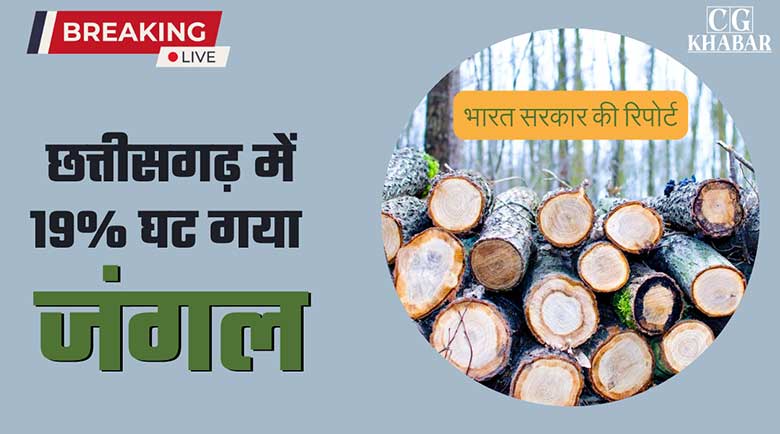Chhattisgarh’s forest loss challenges National cover claims
Raipur | Mamta Mankar: Chhattisgarh’s Forest cover has seen a decline, as highlighted by the latest report from the Forest Survey of India, Government of India.
Interestingly the same report is being cited nationwide to declare Chhattisgarh as a state with highest increase in the forest cover across India.
Whereas the report from Government of India reveals a decline in the forest cover across the Chhattisgarh state.
With 60 percent of state’s districts have experienced reduction.
When discussing forests and trees, we often overlook the broader reality, forests are much more than just trees.
A forest comprises whole of an ecosystem, a place consisting of diverse and vibrant life – people, plants, animals, insects and even the unseen life forms that thrives within.
However, our limited perception of relating forest only with trees has influenced the interpretation of the Forest Survey of India’s (FSI) findings.
This year on December 21, the India State of Forest Report 2023 (ISFR) was released in the First Research Institute of Dehradun.
It was the 18th edition of IFSR series.
The Forest Survey of India conducts an in-depth assessment of the country’s forest and tree resources based on remote sensing satellite data and field-based national forest inventory facts and its results are published in the India Forest Status Report.
Forest Cover Decreases in Chhattisgarh
According to this report, the forest area in Chhattisgarh was 42433.80 square kilometers in 2021. By 2023, it declined and reduced to 42420.39 square kilometers.
Resulting in the loss of 13.41 square kilometers (3352 acres of forest) within two years.
The Forest Survey of India (FSI) notes that tree cover in the state has increased, but this growth is due to plantations in private, agricultural, or residential areas. Tree cover outside forest areas rose by 702.75 square kilometers, yet the overall increase in combined tree and forest cover is just 683.62 square kilometers.
The report highlights that both government and private forest areas have declined, leading to a total forest cover loss of 19.13 square kilometers (4,782 acres) in Chhattisgarh between 2021 and 2023.
Forest loss in districts of Chhattisgarh
The FSI report reveals 17 of the 28 districts have witnessed forest cover decline, affecting 60 of the state. Compared to 2021, many districts have experienced significant forest loss, marking the highest reduction in forest area since the state’s formation.
Reviewing data from the previous year’s reveals that Chhattisgarh has never experienced such significant forest loss since its formation.
In Mungeli district, home to Achanakmar, forest cover has declined by 17.27% over the past two years, leaving just 1,038.52 square kilometers of forest.
Similarly, Gariaband district now has only 2,577.15 square kilometers of forest remaining, a decrease of 11.02% compared to 2021.
In Kabirdham district, the forest area was 1,547.88 square kilometers in 2021. By 2023, it had decreased to 1,532.5 square kilometers, reflecting an 8.44% loss over two years.
In Kondagaon (Bastar division), forest cover has reduced by 7.54%, with 2,165.50 square kilometers remaining.
In Balrampur district, forest area has declined to 3,134.46 square kilometers, showing a loss of 6.45 square kilometers in the past two years.
Talking about other districts of the state, there has been a 5.05 percent reduction in forest area in Mahasamund in two years, 4.38 percent reduction in Rajnandgaon, 3.66 percent reduction in Korba district, 3.24 percent reduction in Korea, 3.10 percent reduction in Surajpur, 2.42 percent reduction in Janjgir Champa district, 2.27 percent reduction in Sukma, 1.81 percent reduction in Durg district, 1.75 percent reduction in Surguja, 1.68 percent reduction in Jashpur, 1.03 percent reduction in Raigarh and 0.90 percent reduction in forest area in Bemetara.
The analysis of forest conditions in the country is also being conducted in a manner similar to that of Chhattisgarh.
The total increase in forest cover across the country is not 1,445 square kilometers, but only 156 square kilometers. Of this, just 7 square kilometers is recorded forest, while 149 square kilometers is unrecorded forest.
The remaining 1,289 square kilometers, consisting of tree cover from plantations, parks, and other types of greenery, is included in the total, contributing to the reported 1,445 square kilometers.




